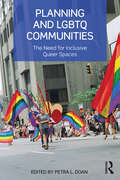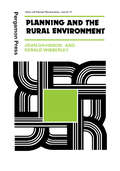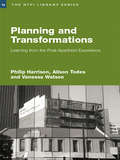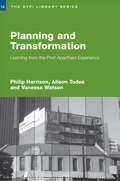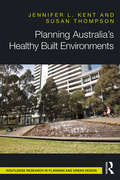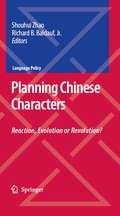- Table View
- List View
Planning and LGBTQ Communities: The Need for Inclusive Queer Spaces
by Petra L. DoanAlthough the last decade has seen steady progress towards wider acceptance of lesbian, gay, bisexual, transgendered, and queer (LGBTQ) individuals, LGBTQ residential and commercial areas have come under increasing pressure from gentrification and redevelopment initiatives. As a result many of these neighborhoods are losing their special character as safe havens for sexual and gender minorities. Urban planners and municipal officials have sometimes ignored the transformation of these neighborhoods and at other times been complicit in these changes. Planning and LGBTQ Communities brings together experienced planners, administrators, and researchers in the fields of planning and geography to reflect on the evolution of urban neighborhoods in which LGBTQ populations live, work, and play. The authors examine a variety of LGBTQ residential and commercial areas to highlight policy and planning links to the development of these neighborhoods. Each chapter explores a particular urban context and asks how the field of planning has enabled, facilitated, and/or neglected the specialized and diverse needs of the LGBTQ population. A central theme of this book is that urban planners need to think "beyond queer space" because LGBTQ populations are more diverse and dispersed than the white gay male populations that created many of the most visible gayborhoods. The authors provide practical guidance for cities and citizens seeking to strengthen neighborhoods that have an explicit LGBTQ focus as well as other areas that are LGBTQ-friendly. They also encourage broader awareness of the needs of this marginalized population and the need to establish more formal linkages between municipal government and a range of LGBTQ groups. Planning and LGBTQ Communities also adds useful material for graduate level courses in planning theory, urban and regional theory, planning for multicultural cities, urban geography, and geographies of gender and sexuality.
Planning and LGBTQ Communities: The Need for Inclusive Queer Spaces
by Petra L. DoanAlthough the last decade has seen steady progress towards wider acceptance of lesbian, gay, bisexual, transgendered, and queer (LGBTQ) individuals, LGBTQ residential and commercial areas have come under increasing pressure from gentrification and redevelopment initiatives. As a result many of these neighborhoods are losing their special character as safe havens for sexual and gender minorities. Urban planners and municipal officials have sometimes ignored the transformation of these neighborhoods and at other times been complicit in these changes. Planning and LGBTQ Communities brings together experienced planners, administrators, and researchers in the fields of planning and geography to reflect on the evolution of urban neighborhoods in which LGBTQ populations live, work, and play. The authors examine a variety of LGBTQ residential and commercial areas to highlight policy and planning links to the development of these neighborhoods. Each chapter explores a particular urban context and asks how the field of planning has enabled, facilitated, and/or neglected the specialized and diverse needs of the LGBTQ population. A central theme of this book is that urban planners need to think "beyond queer space" because LGBTQ populations are more diverse and dispersed than the white gay male populations that created many of the most visible gayborhoods. The authors provide practical guidance for cities and citizens seeking to strengthen neighborhoods that have an explicit LGBTQ focus as well as other areas that are LGBTQ-friendly. They also encourage broader awareness of the needs of this marginalized population and the need to establish more formal linkages between municipal government and a range of LGBTQ groups. Planning and LGBTQ Communities also adds useful material for graduate level courses in planning theory, urban and regional theory, planning for multicultural cities, urban geography, and geographies of gender and sexuality.
Planning and Market in Soviet and East European Thought, 1960s–1992
by Jan AdamThis book discusses the evolution of ideas about the desirable combination of planning and market in the former Soviet Union, Poland, Czechoslovakia and Hungary since the 1960s, when major economic reforms started, up to 1991 when the countries have been engaged in a transformation of their economies into market economies. It also discusses the common and contrasting features of the debates which evolved in the countries under review.
Planning and the Case Study Method in Africa: The Planner in Dirty Shoes
by James Duminy Jørgen Andreasen Fred LeriseThis book addresses the relevance of the case study research methodology for enhancing urban planning research and education in Africa and the global South. It provides an introduction to the case study methodology and features examples of its application to planning research and education on the continent.
Planning and the Political Market: Public Choice and the Politics of Government Failure
by Mark PenningtonPlanning and the Political Market argues that the enthusiasm for planning as an essential component of environmental protection is misplaced. Drawing on the experience of Britain and other Western democracies, the author uses public choice theory to explore the practical experience of land use planning as an example of government failure.The book opens by outlining the institutional focus of public choice theory, examining the central questions of market and government failure and the theoretical case for government intervention in the environment. Having explored the principal impacts of planning the book goes on to analyse the institutional structures which have produced these policy outcomes.The analysis suggests that institutional incentives within the 'political market' have frequently led to policies which favour special interest groups and public sector bureaucracy. The book concludes with an assessment of the potential for a private property rights, free market alternative to increase community involvement and access.
Planning and the Politicians: and Other Essays (Routledge Revivals)
by A. H. HansonFirst published in 1969, Planning and the Politicians is a collection of essays on political subjects, which ranges from a study of the British House of Commons, through a discussion of decentralization in various countries, to an examination of the problems of economic planning in a ‘new’ state. They are arranged in four sections, entitled Parliament, Administration, Development, and Principles. As the book’s title implies, there is a constant preoccupation throughout the essays with the practical issues of politics and public administration, and with the more general problems of political choice that face the individual in the modern world. An introductory essay explains the author’s personal approach to political studies. The book will be of interest to students of political science, governance, administration, and economics.
Planning and the Politicians: and Other Essays (Routledge Revivals)
by A. H. HansonFirst published in 1969, Planning and the Politicians is a collection of essays on political subjects, which ranges from a study of the British House of Commons, through a discussion of decentralization in various countries, to an examination of the problems of economic planning in a ‘new’ state. They are arranged in four sections, entitled Parliament, Administration, Development, and Principles. As the book’s title implies, there is a constant preoccupation throughout the essays with the practical issues of politics and public administration, and with the more general problems of political choice that face the individual in the modern world. An introductory essay explains the author’s personal approach to political studies. The book will be of interest to students of political science, governance, administration, and economics.
Planning and the Rural Environment: Urban and Regional Planning Series
by Joan Davidson Gerald WibberleyPlanning and the Rural Environment examines the environmental issues affecting countryside planning. Emphasis is placed on the look and feel of the open countryside, the function and appearance of the rural environment, rather than the problems of its people and the settlements in which they live. Also discussed is the conflict of interest generated between some of the major planning systems concerned with the development of rural activities and the protection of rural resources. Comprised of 13 chapters, this volume begins with an assessment of conflicting views of how a countryside of the future should develop and the degree of control and direction that should take place. The following chapters consider how the emerging range of environmental problems and opportunities in rural planning can best be illustrated. In particular, the dominance of agriculture as a rural activity is analyzed, together with forest and woodland management; leisure activity in the countryside; and conservation of resources and wildlife. The next section is devoted to uplands and the urban fringe, paying particular attention to some of the ways in which rural interests interact in two very different areas. Finally, the development of rural planning is reviewed and issues that are expected to shape the countryside of the future are considered. This book should be of interest to postgraduate students of rural planning and specialists in various fields of countryside planning.
Planning and Transformation: Learning from the Post-Apartheid Experience (RTPI Library Series)
by Philip Harrison Alison Todes Vanessa WatsonPlanning and Transformation provides a comprehensive view of planning under political transition in South Africa, offering an accessible resource for both students and researchers in an international and a local audience. In the years after the 1994 transition to democracy in South Africa, planners believed they would be able to successfully promote a vision of integrated, equitable and sustainable cities, and counter the spatial distortions created by apartheid. This book covers the experience of the planning community, the extent to which their aims were achieved, and the hindering factors. Although some of the factors affecting planning have been context-specific, the nature of South Africa’s transition and its relationship to global dynamics have meant that many of the issues confronting planners in other parts of the world are echoed here. Issues of governance, integration, market competitiveness, sustainability, democracy and values are significant, and the particular nature of the South African experience lends new insights to thinking on these questions, exploring the possibilities of achievement in the planning field.
Planning and Transformation: Learning from the Post-Apartheid Experience (RTPI Library Series)
by Philip Harrison Alison Todes Vanessa WatsonPlanning and Transformation provides a comprehensive view of planning under political transition in South Africa, offering an accessible resource for both students and researchers in an international and a local audience. In the years after the 1994 transition to democracy in South Africa, planners believed they would be able to successfully promote a vision of integrated, equitable and sustainable cities, and counter the spatial distortions created by apartheid. This book covers the experience of the planning community, the extent to which their aims were achieved, and the hindering factors. Although some of the factors affecting planning have been context-specific, the nature of South Africa’s transition and its relationship to global dynamics have meant that many of the issues confronting planners in other parts of the world are echoed here. Issues of governance, integration, market competitiveness, sustainability, democracy and values are significant, and the particular nature of the South African experience lends new insights to thinking on these questions, exploring the possibilities of achievement in the planning field.
Planning and Zoning New York City
by Todd BressiTwo unique events shaped the magnificent unnatural geography of New York City and created its sense of place: the Commissioners' Plan of 1811 and the zoning resolution of 1916. The first imprinted Manhattan with a two-dimensional plan, a rectangular grid defined by broad north-south avenues, multiple east-west cross streets, and by its standard units: blocks of two hundred feet by six hundred to eight hundred feet. The second determined the city's three-dimensional form by restricting uses by district, by limiting the maximum mass of a building allowed on a given site.This book addresses the fundamental challenge facing every American municipality: Can zoning - the basic tool of municipal land-use control - balance growth and equity? As New York plans for the future, the nation's foremost commentators on urban planning, architecture, land-use law, and design discuss the accomplishments of New York's zoning laws and explore alternative scenarios for guiding the city's future development.The chapters in this book were originally prepared for a symposium on the history and future of planning in New York City. The authors provide a skillful blend of urban history, architectural review, economic analysis, and social commentary. Contributors include such experts as Jonathan Barnett, Sigurd Grava, Frances Halsband, Jerold Kayden, Brian Kintish, Eric Kober, Michael Kwartler, Larry Littlefield, Norman Marcus, R. Susan Motley, Richard A. Plunz, Peter D. Salins, Richard L. Schaffer, John Shapiro, Robert A. M. Stern, Roy Strickland, Marilyn Taylor, Robert F. Wagner, Jr., and Carol Willis. This book is essential reading for planners, architects, historians, developers, and municipal officials concerned with guiding the future of America's cities. Its lessons are vital for every city in America.
Planning and Zoning New York City
by Todd BressiTwo unique events shaped the magnificent unnatural geography of New York City and created its sense of place: the Commissioners' Plan of 1811 and the zoning resolution of 1916. The first imprinted Manhattan with a two-dimensional plan, a rectangular grid defined by broad north-south avenues, multiple east-west cross streets, and by its standard units: blocks of two hundred feet by six hundred to eight hundred feet. The second determined the city's three-dimensional form by restricting uses by district, by limiting the maximum mass of a building allowed on a given site.This book addresses the fundamental challenge facing every American municipality: Can zoning - the basic tool of municipal land-use control - balance growth and equity? As New York plans for the future, the nation's foremost commentators on urban planning, architecture, land-use law, and design discuss the accomplishments of New York's zoning laws and explore alternative scenarios for guiding the city's future development.The chapters in this book were originally prepared for a symposium on the history and future of planning in New York City. The authors provide a skillful blend of urban history, architectural review, economic analysis, and social commentary. Contributors include such experts as Jonathan Barnett, Sigurd Grava, Frances Halsband, Jerold Kayden, Brian Kintish, Eric Kober, Michael Kwartler, Larry Littlefield, Norman Marcus, R. Susan Motley, Richard A. Plunz, Peter D. Salins, Richard L. Schaffer, John Shapiro, Robert A. M. Stern, Roy Strickland, Marilyn Taylor, Robert F. Wagner, Jr., and Carol Willis. This book is essential reading for planners, architects, historians, developers, and municipal officials concerned with guiding the future of America's cities. Its lessons are vital for every city in America.
Planning Appeals: Practice and Materials
by Richard Kimblin QCA concise collation of the relevant materials for each relevant stage of an appeal. Taking costs applications as an example, it brings together: the statutory basis for a costs award; the relevant procedure rules; the guidance in the National Planning Practice Guidance; summaries or extracts example costs decisions which show how particular points are often decided and provides commentary and observations.Preparing. Provides a step by step guide to framing a case, supporting it with effective evidence and advice on how to avoid pitfalls.Giving evidence. The focus of any appeal is the inquiry or hearing. The function of the inquiry and its key elements have to be understood in order to be effective within it. It covers the benefits of a good examination in chief; what can be achieved during cross examination and how are you (as witness, client, solicitor) going to contribute; does re-examination matter and how does all this relate to what is said ultimately in closing submissions?The Rosewell Review. Provides detailed explanation of the impact of the Rosewell Review.
Planning as Persuasive Storytelling: The Rhetorical Construction of Chicago's Electric Future (New Practices of Inquiry)
by James A. ThrogmortonPlanning as Persuasive Storytelling is a revealing look at the world of political conflict surrounding the Commonwealth Edison Company's ambitious nuclear power plant construction program in northern Illinois during the 1980s. Examining the clash between the utility, consumer groups, community-based groups, the Illinois Commerce Commission, and the City of Chicago, Throgmorton argues that planning can best be thought of as a form of persuasive storytelling. A planner's task is to write future-oriented texts that employ language and figures of speech designed to persuade their constituencies of the validity of their vision. Juxtaposing stories about efforts to construct Chicago's electric future, Planning as Persuasive Storytelling suggests a shift in how we think about planning. In order to account for the fragmented and conflicted nature of contemporary American life and politics, that shift would be away from "science" and the "experts" and toward rhetoric and storytelling.
Planning Atlanta
by Harley F. Etienne Barbara FagaMore than any other major U.S. city, Atlanta regularly reinvents itself. From the Civil War’s devastation to the 1996 Olympic boom to the current housing crisis, the city’s history is a cycle of rise and fall, ruin and resurgence. In Planning Atlanta, two dozen planning practitioners and thought leaders bring the story to life. Together they trace the development of projects like Freedom Parkway and the Jimmy Carter Presidential Library. They examine the impacts of race relations on planning and policy. They explore Atlanta’s role as a 19th-century rail hub—and as the home of the world’s busiest airport. They probe the city’s economic and environmental growing pains. And they look toward new plans that will shape Atlanta’s next incarnation. Read Planning Atlanta and discover a city where change is always in the wind.
Planning Atlanta
by Harley F. Etienne Barbara FagaMore than any other major U.S. city, Atlanta regularly reinvents itself. From the Civil War’s devastation to the 1996 Olympic boom to the current housing crisis, the city’s history is a cycle of rise and fall, ruin and resurgence. In Planning Atlanta, two dozen planning practitioners and thought leaders bring the story to life. Together they trace the development of projects like Freedom Parkway and the Jimmy Carter Presidential Library. They examine the impacts of race relations on planning and policy. They explore Atlanta’s role as a 19th-century rail hub—and as the home of the world’s busiest airport. They probe the city’s economic and environmental growing pains. And they look toward new plans that will shape Atlanta’s next incarnation. Read Planning Atlanta and discover a city where change is always in the wind.
Planning Australia’s Healthy Built Environments
by Jennifer L. Kent Susan ThompsonPlanning Australia’s Healthy Built Environments shines a quintessentially Australian light on the links between land use planning and human health. A burgeoning body of empirical research demonstrates the ways urban structure and governance influences human health—and Australia is playing a pivotal role in developing understandings of the relationships between health and the built environment. This book takes a retrospective look at many of the challenges faced in pushing the healthy built environment agenda forward. It provides a clear and theoretically sound framework to inform this work into the future. With an emphasis on context and the pursuit of equity, Jennifer L. Kent and Susan Thompson supply specific ways to better incorporate idiosyncrasies of place and culture into urban planning interventions for health promotion. By chronicling the ways health and the built environment scholarship and practice can work together, Planning Australia’s Healthy Built Environments enters into new theoretical and practical debates in this critically important area of research. This book will resonate with both health and built environment scholars and practitioners working to create sustainable and health-supportive urban environments.
Planning Australia’s Healthy Built Environments
by Jennifer L. Kent Susan ThompsonPlanning Australia’s Healthy Built Environments shines a quintessentially Australian light on the links between land use planning and human health. A burgeoning body of empirical research demonstrates the ways urban structure and governance influences human health—and Australia is playing a pivotal role in developing understandings of the relationships between health and the built environment. This book takes a retrospective look at many of the challenges faced in pushing the healthy built environment agenda forward. It provides a clear and theoretically sound framework to inform this work into the future. With an emphasis on context and the pursuit of equity, Jennifer L. Kent and Susan Thompson supply specific ways to better incorporate idiosyncrasies of place and culture into urban planning interventions for health promotion. By chronicling the ways health and the built environment scholarship and practice can work together, Planning Australia’s Healthy Built Environments enters into new theoretical and practical debates in this critically important area of research. This book will resonate with both health and built environment scholars and practitioners working to create sustainable and health-supportive urban environments.
Planning Better Cities: A Practical Guide
by Halvard DalheimThis textbook provides an accessible, practical guide to the strategic planning process required for the preparation of city plans from entire metropolitan areas to town centres. It fills a gap in the academic literature on the topic of strategic planning. Its conceptual and practical content together with a student friendly style and high use of practical examples make it accessible to both the student and recent graduate. Its presentation in three parts allows the reader or course leader to access those sections relevant to either their learning requirements or day-to-day work activities. The book is clearly structured into three-parts and provides flexibility in approach and learning for students taking relevant planning courses. The extensive reading list at the conclusion of each chapter provides the student with an opportunity to explore in more detail the individual topics. The practical approach equips the recent graduate with a deeper understanding of the purpose of each element of strategic planning from how to prepare a research brief to how to approach community engagement activities.
Planning Chicago
by D. Bradford Hunt Jon B DeVriesIn this volume the authors tell the real stories of the planners, politicians, and everyday people who shaped contemporary Chicago, starting in 1958, early in the Richard J. Daley era. Over the ensuing decades, planning did much to develop the Loop, protect Chicago’s famous lakefront, and encourage industrial growth and neighborhood development in the face of national trends that savaged other cities. But planning also failed some of Chicago’s communities and did too little for others. The Second City is no longer defined by its past and its myths but by the nature of its emerging postindustrial future. This volume looks beyond Burnham’s giant shadow to see the sprawl and scramble of a city always on the make. This isn’t the way other history books tell the story. But it’s the Chicago way.
Planning Chicago
by D. Bradford Hunt Jon B DeVriesIn this volume the authors tell the real stories of the planners, politicians, and everyday people who shaped contemporary Chicago, starting in 1958, early in the Richard J. Daley era. Over the ensuing decades, planning did much to develop the Loop, protect Chicago’s famous lakefront, and encourage industrial growth and neighborhood development in the face of national trends that savaged other cities. But planning also failed some of Chicago’s communities and did too little for others. The Second City is no longer defined by its past and its myths but by the nature of its emerging postindustrial future. This volume looks beyond Burnham’s giant shadow to see the sprawl and scramble of a city always on the make. This isn’t the way other history books tell the story. But it’s the Chicago way.
Planning Chinese Characters: Reaction, Evolution or Revolution? (Language Policy #9)
by Shouhui Zhao Richard B. BaldaufThis book presents the most comprehensive synthesis and analysis of major developments in reforming programs in modernizing the Chinese writing system. It traces the language policy and planning related developments for Chinese characters, with particular emphasis on post-1950 period in the People’s Republic of China (PRC) and the more recent challenges that technology, and particularly the World Wide Web, have posed for the language.
Planning Cities in Africa: Current Issues and Future Prospects of Urban Governance and Planning (The Urban Book Series)
by Genet Alem Gebregiorgis Stefan Greiving Ally Hassan Namangaya Wilbard Jackson KombeThis open access book provides insights into challenges, threats and opportunities of urban development in Africa. It discusses how and why African cities need localised urban planning concepts and theories to deal with challenges and threats of rapid urbanisation and climate change. The book delivers an in-depth view of the nature and gaps of the framework on which current planning practice and education in Africa are based. With that, it discusses the potentials of African cities to mobilise local knowledge, resources and capacity building for sustained and resilient urban growth.This work is addressed to educationists and practitioners in the field of urban development management, climate change adaptation and urban resilience. Specifically, such audiences include researchers, spatial planners, graduate students and member of civil societies working on urban development management.
